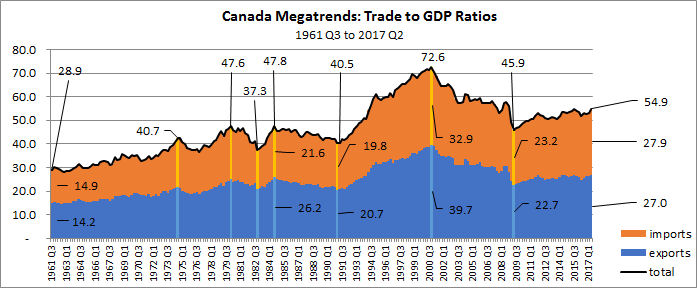The Economics and Statistics Division maintains archives of previous publications for accountability purposes, but makes no updates to keep these documents current with the latest data revisions from Statistics Canada. As a result, information in older documents may not be accurate. Please exercise caution when referring to older documents. For the latest information and historical data, please contact the individual listed to the right.
<--- Return to Archive
For additional information relating to this article, please contact:
October 03, 2017CANADA INTERNATIONAL MERCHANDISE TRADE MEGA TRENDS On September 29, 2017, Statistics Canada published a paper on Canadian merchandise trade trends over the period 1961 to 2016. Three things are apparent from the report and supporting data:
- Merchandise export trade growth has grown faster than GDP
- Merchandise import trade growth has also grown faster than GDP
- Merchandise net trade has been in surplus over most of the period, but slid into deficit territory after the global trade collapse in 2009.

The importance of international merchandise trade can be revealed by computing an openness measure (trade to GDP ratio). Over the period 1962 to 2000 the international merchandise trade to GDP ratio more than doubled from 28.9 to 72.6. Two components of the merchandise trade are export and import trade. The export to GDP ratio increased 25.5 points, from 14.2 to 39.7 and the import trade to GDP ratio increased 18.0 points to 32.9, between 1962 and 2000.
After 2000 merchandise trade contracted. The merchandise trade to GDP computation declined 16.6 points from 2000 to 2008, and declined sharply, a further 10.1 points by the 2nd quarter of 2009 to 45.9 Import to GDP ratio declined 9.7 points to 23.2 points, and the export to GDP ratio declined 17.0 point. to 22.7. Imports now took the lead over exports.
By the 2nd quarter of 2017, the merchandise trade to GDP ratio had increased 9.0 point to 54.9, imports to GDP had increased 4.7 points to 27.9, and exports to GDP had increased 4.3 points to 27.0. International merchandise trade was expanding in all markets. However, with imports leading the way, Canada was in trade deficit.

In 1962, Canada posted a merchandise trade surplus of $307 million. Over the period 1962 to 2008, international merchandise trade surpluses were reported in all but one year (1975). In 2001, Canada reported a record $69.5 billion surplus. From 2001 to 2008, the annual surplus declined, coming in at $43.7 million in 2008. In 2009, merchandise trade collapsed, and Canada posted a $6.8 billion trade deficit.
The period of 2009 to 2016 has been one of increasing higher trade deficit. By 2016, the annual trade deficit had increased to $26.0 billion.
Statistics Canada
STC Daily, September 29, 2017: Canadian Megatrends: Canada's exports over time: Resources and manufactured goods
Publication: Canada's exports over time: Resources and manufactured goods" is now available as part of Canadian Megatrends (Catalogue number11-630-X).
CANSIM: 228-0001, 228-0069, 376-0006, 376-0107, and 380-0064
<--- Return to Archive